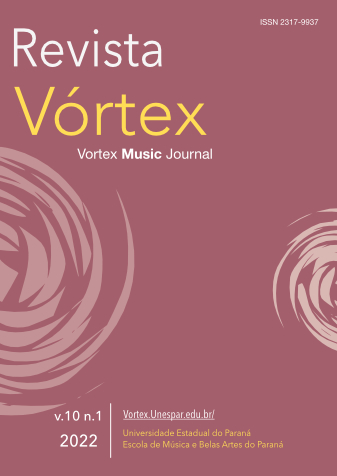A Networked Hybrid Interface for Audience Sonification and Machine Learning
DOI:
https://doi.org/10.33871/23179937.2022.10.1.4695Palavras-chave:
Sonifications, Live Coding, Networked Music System, Improvisation, Web ApplicationResumo
Lick the Toad is an ongoing project developed as a web based interface that runs in modern browsers. It provides a custom made platform to collect user data accessed from mobile devices, such as smartphones, tablets etc. The system offers a tool for interactive collective sonification supporting networked music performance. It can be used in various contexts, such as an onsite installation, or for the distribution of raw data for live coding performances making it a versatile component for an array of creative practices. Of these, live coding which is one of the author's artistic approach to create live performances is demonstrated in this article highlighting and elaborating on technical and musical aspects of this approach. Final sections outline the system as a tool for live coding performances and cover a series of potential interactions integrating audience and/or using it independently alike.Downloads
Referências
AMERSHI, S.; CAKMAK, M.; KNOX, W.B.; KULESZA, T. Power to the People: The Role of Humans in Interactive Machine Learning. AI Magazine, [online] 35(4), pp.105–120, 2014. https://doi.org/10.1609/aimag.v35i4.2513
BAALMAN, M. the machine is learning. [Personal Website] Marije Baalman. 2020. Available at: <https://marijebaalman.eu/projects/the-machine-is-learning.html> [Accessed 16 April 2021].
CHAFE, C. Ping. 2001.
COLLINS, N.; MCLEAN, A.; ROHRHUBER, J.; WARD, A. Live coding in laptop performance. Organised Sound, [online] 8(3), pp.321–330, 2003. https://doi.org/10.1017/S135577180300030X
CRAB, S. The "˜Telharmonium"™ or "˜Dynamophone"™ Thaddeus Cahill, USA 1897. 120 Years of Electronic Music. 2013. Available at: <https://120years.net/wordpress/the-telharmonium-thaddeus-cahill-usa-1897/> [Accessed 5 April 2022].
FIEBRINK, R.; SONAMI, L. Reflections on Eight Years of Instrument Creation with Machine Learning. In: R. Michon and F. Schroeder, eds. Proceedings of the International Conference on New Interfaces for Musical Expression. [online] Birmingham, UK: Birmingham City University. pp.282–288, 2020. Available at:
GRESHAM-LANCASTER, S. The Aesthetics and History of the Hub: The Effects of Changing Technology on Network Computer Music. Leonardo Music Journal 8 (1998): 39. https://doi.org/10.2307/1513398
HERMANN, T.; HUNT, A.; NEUHOFF, J. G. (eds). The Sonification Handbook. Berlin: Logos Verlag, 2011.
L. STURM, B.; BEN-TAL, O. Taking the Models back to Music Practice: Evaluating Generative Transcription Models built using Deep Learning. Journal of Creative Music Systems, [online] 2(1), 2017. https://doi.org/10.5920/JCMS.2017.09
LUKA, 2019. Live Coding and Algorave. [online] Medium. Available at: <https://lukabaramishvili.medium.com/live-coding-and-algorave-9eee0ca0217f> [Accessed 14 April 2021].
MANNING, P. Electronic and computer music. Rev. and expanded ed ed. Oxford ; New York: Oxford University Press, 2004.
NILSON, C. Live coding practice. In: Proceedings of the 7th international conference on New interfaces for musical expression - NIME "™07. [online] the 7th international conference. New York, New York: ACM Press. p.112, 2007. https://doi.org/10.1145/1279740.1279760
SMITH, O.; TACCHINI, F. Network Ensemble Selected Network Studies. Number SF0010 in The Strong of the Future. Rizosfera, Via Guido de Ruggiero, 6 – 42123, Reggio Emilia – Italia, 2017.
VASILAKOS, K. Exploring Live Coding as Performance Practice. 2021, [online] 21(Guz 2021), pp. 21–38, 2021. Available at: <https://dergipark.org.tr/tr/pub/porteakademik/issue/66105/1033868> [Accessed 7 February 2022].
VASILAKOS, K.; WILSON, S.; MCCAULEY, T.; YEUNG, T.W.; MARGETSON, E; KHOSRAVI MARDAKHEH, M. Sonification of High Energy Physics Data Using Live Coding and Web Based Interfaces. In: R. Michon and F. Schroeder, eds. Proceedings of the International Conference on New Interfaces for Musical Expression. [online] Birmingham, UK: Birmingham City University. pp. 464–470, 2020. Available at:
WORRALL, D. Sonification Design: From Data to Intelligible Soundfields. Springer Publishing Company, Incorporated, 1st edition, 2019.
ZMÖLNIG, Io.; ECKEL, G. Live coding: An overview. International Computer Music Conference, ICMC 2007, pp. 295–298, 2007.
Downloads
Publicado
Como Citar
Edição
Seção
Licença
Copyright (c) 2022 Konstantinos Vasilakos

Este trabalho está licenciado sob uma licença Creative Commons Attribution 4.0 International License.
Autores mantêm os direitos autorais e concedem à revista o direito de primeira publicação, com o trabalho simultaneamente licenciado sob a Licença Creative Commons Attribution que permite o compartilhamento do trabalho com reconhecimento da autoria e publicação inicial nesta revista.






